 Return
to Online Library listing
Return
to Online Library listing
 Return
to Online Library listing
Return
to Online Library listing
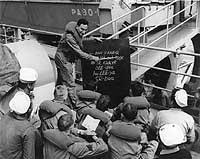
This page features the Online Library's 'What's New?' entries for April through October 2005.
For the more recent entries, and links to previous years'
entries, see:
For earlier entries from the year 2005, see:
| If you want higher resolution reproductions than the Online Library's digital images, see: How to Obtain Photographic Reproductions. |
 New
presentation production in October mainly consisted of World War
I era ships, to a great extent the residue of uncompleted projects
begun during the spring and summer. While introductory text remains
to be written on a few items, the photos and their captions are
all in place.
New
presentation production in October mainly consisted of World War
I era ships, to a great extent the residue of uncompleted projects
begun during the spring and summer. While introductory text remains
to be written on a few items, the photos and their captions are
all in place.
A major presentation on the USS S-4
(Submarine # 109) leads the way, with (among other things)
a fine series of of interior photographs and coverage on her tragic loss in December
1927 and the subsequent salvage operation. Three even older
submarines were also added: USS L-5
(Submarine # 44), USS O-6
(Submarine # 67) and USS R-2
(Submarine # 79).
![]() A
Really Big (nearly matching the size of the ship) presentation
was generated on the huge World War I transport Leviathan
(ID # 1326), which held the record as the Navy's largest ship
for two and a half decades. As S.S. Leviathan,
this German-built (as S.S. Vaterland) passenger liner also
the U.S. Flag merchant marine's biggest ship for some thirty years.
Her near-sister, Imperator,
whose page was done early in 2004, received some new pictures
in the course of the Leviathan project.
A
Really Big (nearly matching the size of the ship) presentation
was generated on the huge World War I transport Leviathan
(ID # 1326), which held the record as the Navy's largest ship
for two and a half decades. As S.S. Leviathan,
this German-built (as S.S. Vaterland) passenger liner also
the U.S. Flag merchant marine's biggest ship for some thirty years.
Her near-sister, Imperator,
whose page was done early in 2004, received some new pictures
in the course of the Leviathan project.
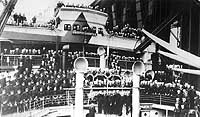 Four
other "Great War" era troop transports also joined the
Online Library during the month, some with multi-page presentations.
They include USS Orizaba,
which saw service in both World Wars; USS Pocahontas,
whose long-running reunion association bequeathed its photo albums
to the Naval Historical Center in 1974; USS Saint
Louis (of 1898, which was USS Louisville in 1918-1919)
-- an expansion and reworking of one of the Online Library's ancient
(ie: 1998) productions; and the delivered but never commissioned
transport Sol Navis,
which had a long subsequent commercial career that ended with
her loss, without survivors, during World War II's Battle of the
Atlantic.
Four
other "Great War" era troop transports also joined the
Online Library during the month, some with multi-page presentations.
They include USS Orizaba,
which saw service in both World Wars; USS Pocahontas,
whose long-running reunion association bequeathed its photo albums
to the Naval Historical Center in 1974; USS Saint
Louis (of 1898, which was USS Louisville in 1918-1919)
-- an expansion and reworking of one of the Online Library's ancient
(ie: 1998) productions; and the delivered but never commissioned
transport Sol Navis,
which had a long subsequent commercial career that ended with
her loss, without survivors, during World War II's Battle of the
Atlantic.
 Speaking
of World War II, four other ships of that era were posted, among
them the frigate Hutchinson
(PF-45), hospital ship Hope
(AH-7), and two attack transports: Carteret
(APA-70) and James O'Hara
(APA-90). The latter's long post-World War II service as a
troop transport (T-AP-179) is included.
Speaking
of World War II, four other ships of that era were posted, among
them the frigate Hutchinson
(PF-45), hospital ship Hope
(AH-7), and two attack transports: Carteret
(APA-70) and James O'Hara
(APA-90). The latter's long post-World War II service as a
troop transport (T-AP-179) is included.
We'll wrap up this report with a long list of freshly-prepared
World War I era ships. Patrol vessels include the converted yachts
Ranger (SP-237)
and Sabalo (SP-225),
plus seven patrol boats: Desire
(SP-786), Dianthus
(SP-639), Dicky
(SP-231), Dixie III
(SP-701), Dodger II
(SP-46), Dohema Jr.
(SP-612) and Get There
(SP-579).
Logistics ships are represented by a tanker and a "dishonest
baker's dozen" of cargo ships. The former is W.L.
Steed (ID # 3449), another ship with long commercial service
which was a victim of the World War II U-boat campaign. The cargo
ships are: Dakotan
(ID # 3882), Dochra
(ID # 1758), Edgecombe
(ID # 3894), Felix
Taussig (ID # 2282), Invincible
(ID # 3671), Rondo
(ID # 2488), Victorious
(ID # 3514), West
Avenal (ID # 3871), West
Carnifax (ID # 3812), West
Galeta (ID # 3330) and West
Humhaw (ID # 3718).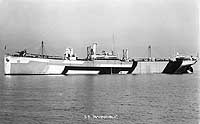 No,
we are not making up those "West" names -- the Navy
inherited them from the U.S. Shipping Board, where somebody in
the name assignment business appears to have had a sense of humor
that matched the bizarre camouflage designs that were common in
1918.
No,
we are not making up those "West" names -- the Navy
inherited them from the U.S. Shipping Board, where somebody in
the name assignment business appears to have had a sense of humor
that matched the bizarre camouflage designs that were common in
1918.
There are a handful of service types: salvage tugs Rescue
(ID # 3209) and Tasco
(SP-502) of 1909; barges Derry
(ID # 1391) and Diascond
(ID # 2385); and the derrick lighter Derrick
Barge # 70 (ID # 2635).
Finally, we have two ships that were considered for Naval service,
but not taken up: the freighter Coronado
of 1918 and the tanker Georgia
of 1908.
31 October 2005
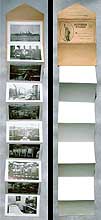 Those
with long memories may recall the last of the Online Library's
"What's New" columns, but everyone else will just have
to be satisfied with an assurance that such things were, in fact,
provided in the past. With some luck, they will appear regularly
in the future.
Those
with long memories may recall the last of the Online Library's
"What's New" columns, but everyone else will just have
to be satisfied with an assurance that such things were, in fact,
provided in the past. With some luck, they will appear regularly
in the future.
Anyway, we have not been completely unproductive since the end
of March of "'Aught-five". One new topic joined the
front page, providing the beginnings of what may become substantial
coverage on "Souvenir Folders",
which serve much the same function as picture postcards, while
offering many images in a single package. The examples we have
received thus far all concern World War I era troop transports.
Three new people were added to the Online Library population,
all of whom had distinguished Navy careers. They are Rear Admiral
Hiram Paulding (1797-1878),
whose service began before the War of 1812 and extended past the
Civil War; Rear Admiral Caspar
Goodrich (1847-1925); and Rear Admiral Bradley
A. Fiske (1854-1942). The latter two officers were among the
Navy's leading intellectual figures during the last years of the
19th and early years of the 20th Centuries. In 1913-1915 Fiske
was also the Secretary of the Navy's Aide for Operations, a position
that soon became that of Chief of Naval Operations.
 Also
posted was coverage of four destroyer types named for these officers:
USS Paulding (Destroyer
# 22), USS Goodrich
(DD/DDR-831), USS Fiske
(DE-143) and USS Fiske
(DD/DDR-842).
Also
posted was coverage of four destroyer types named for these officers:
USS Paulding (Destroyer
# 22), USS Goodrich
(DD/DDR-831), USS Fiske
(DE-143) and USS Fiske
(DD/DDR-842).
Several other combat ships were also done, including the torpedo
boat Talbot (Torpedo
Boat # 15); destroyers Israel
(Destroyer # 98), Laub
(Destroyer # 263), Laub
(DD-613) and Stephen
Potter (DD-538); and submarines L-3
(Submarine # 42), O-3
(Submarine # 64), R-1
(Submarine # 78) and Seadragon
(SS-194).
Newly added auxiliary ships of the World War II and later eras
are: transport Wharton
(AP-7); submarine tender Antaeus
(AS-21), which later became the hospital ship Rescue
(AH-18); hospital ships Haven
(AH-12) and Consolation
(AH-15); and store ships Karin
(AF-33), Athanasia
(AF-41), Gordonia
(AF-43) and Octavia
(AF-46).
 .
"New" World War I era patrol vessels include converted
yachts Niagara (SP-136,
later PY-9), Nokomis
(SP-609, later PY-6) and Noma
(SP-131); ex-fishing vessels Davis
K. Philips (SP-978) and Delaware
(SP-467); and patrol boats Daisy
(SP-1186), Daraga
(SP-43), Dauntless
(SP-1002), Dawn
(SP-26), DeGrasse
(ID # 1217) and Pomander
(SP-702).
.
"New" World War I era patrol vessels include converted
yachts Niagara (SP-136,
later PY-9), Nokomis
(SP-609, later PY-6) and Noma
(SP-131); ex-fishing vessels Davis
K. Philips (SP-978) and Delaware
(SP-467); and patrol boats Daisy
(SP-1186), Daraga
(SP-43), Dauntless
(SP-1002), Dawn
(SP-26), DeGrasse
(ID # 1217) and Pomander
(SP-702).
Freshly posted auxiliaries of that era are oiler Alameda
(AO-10), cargo ships Defiance
(ID # 3327) and Democracy
(ID # 2215); and the steam lighter Dana.
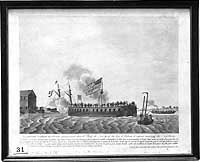 One
19th Century ship was posted, the steam battery Fulton
of 1814, which was also known as "Demologos" and "Fulton
the First" and was the Navy's first steam-powered ship. The
U.S. Army and the British Navy each gained two ships. The Army
vessels served as both transports and hospital ships: transport
Agwileon,
which was later the hospital ship Shamrock; and hospital
ship Dogwood,
which became the transport George Washington Carver. The
Brits are a pair of cruisers: Devonshire,
an armored cruiser of 1904, and the late 1920s heavy cruiser Devonshire.
One
19th Century ship was posted, the steam battery Fulton
of 1814, which was also known as "Demologos" and "Fulton
the First" and was the Navy's first steam-powered ship. The
U.S. Army and the British Navy each gained two ships. The Army
vessels served as both transports and hospital ships: transport
Agwileon,
which was later the hospital ship Shamrock; and hospital
ship Dogwood,
which became the transport George Washington Carver. The
Brits are a pair of cruisers: Devonshire,
an armored cruiser of 1904, and the late 1920s heavy cruiser Devonshire.
Finally, we added eight civilian vessels: "banana boat"
Abangarez of
1909; collier Coastwise
of 1910; yawl Dawn
of 1916; freighter Georgian
(previously named Cajacet and Willsolo) of 1920;
coastal passenger steamers Allegheny
(later American Seafarer) and City
of Chattanooga (later American Navigator) of 1923;
passenger liner Brazil
(originally named Virginia) of 1928; and freighter Lightning of 1942.
29 September 2005
This page features the Online Library's 'What's New?' entries for April through October 2005.
For the more recent entries, and links to previous years'
entries, see:
For earlier entries from the year 2005, see:
| If you want higher resolution reproductions than the Online Library's digital images, see: How to Obtain Photographic Reproductions. |
Page made 31 October 2005